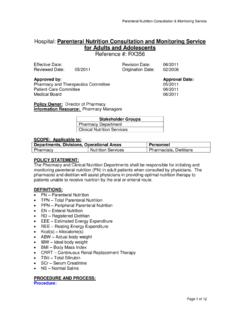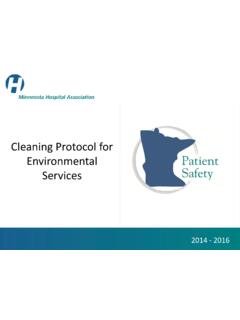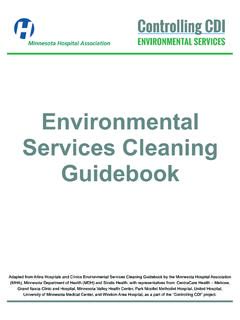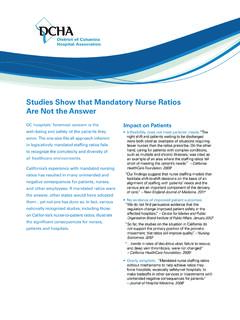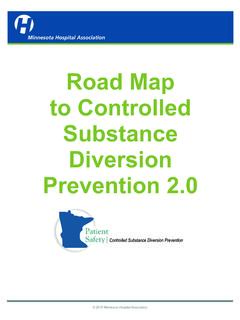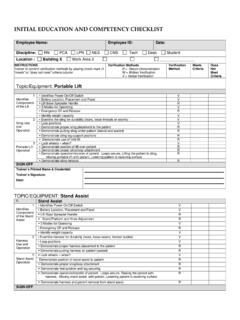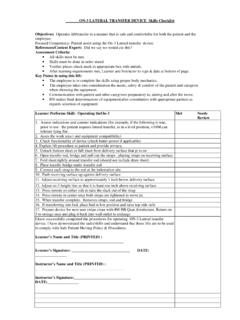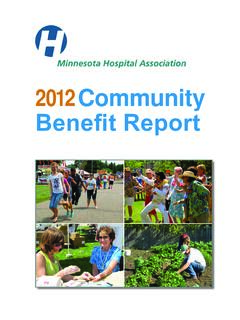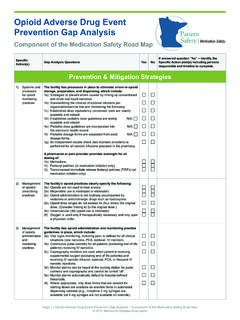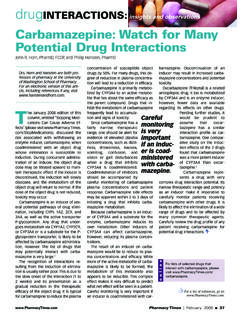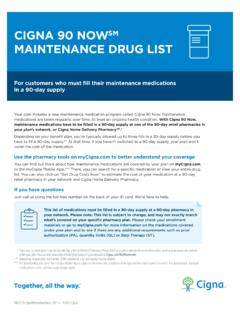Transcription of Neecham Confusion Tool - Minnesota Hospital Association
1 Neecham Confusion tool Confusion Risk Screen Date/Time/Initials Reason for Screen admission, daily, status change Age> = 75 years? Yes No Yes No Yes No History of Acute Confusion ? Yes No Yes No Yes No Pre-existing Brain Damage? Yes No Yes No Yes No History of Depression? Yes No Yes No Yes No Immobility? Yes No Yes No Yes No Sensory Impairment? Yes No Yes No Yes No If any Yes Boxes are checked, complete the Neecham Confusion Scale. Neecham Confusion Scale Date/Time/Initials Score Score Score Score Score Score Level One Processing Attention 4 Full attentiveness/alertness 3 Short or hyper attention/alertness 2 Attention/Alertness inconsistent or inappropriate 1 Attention/Alertness disturbed 0 Arousal/responsiveness depressed Level Two-Behavior-Verbal 4 Initiates speech appropriately 3 - Limited speech initiation 2 Inappropriate speech 1 Speech/sound disturbed 0 Abnormal sounds Level One Processing Command 5 Able to follow a complex command 4 Slowed complex command response 3 Able to follow a simple command 2 Unable to follow a direct command 1 Unable to follow visually guided command 0 Hypoactive, lethargic Vital Function Stability 2 BP, HR, Temp, Respiration in Normal range 1 One of the above in abnormal range 0 Two or more in abnormal range Normals.
2 Temperature = 36-37 Level One Processing- Orientation 5 Oriented to time, place, and person 4 Oriented to person and place 3 Orientation inconsistent 2 Disoriented and memory/recall disturbed 1 - Disoriented, disturbed recognition 0 Processing of stimuli depressed Systolic BP = 100-160 Diastolic BP = 50-90 Heart Rate = 60-100 reg/irreg Respirations = 14-22 Oxygen Saturation Stability 2 O2 Sat in normal range 993 or above) 1 O2 Sat 90 to 92 or is receiving oxygen 0 O2 Sat is below 90 Level Two Behavior Appearance 2 Controls posture, maintains appearance, hygiene 1 Either posture or appearance disturbed 0 Both posture and appearance abnormal Urinary Continence Control 2 Maintains bladder control 1 Incontinent of urine in last 24 hours or has condom cath 0 incontinent or had indwell/intermittent catheter or is anuric Level Two Behavior Motor 4 Normal motor behavior 3 Motor behavior slowed or hyperactive 2 Motor movement disturbed 1 Inappropriate, disrupted movements 0 Motor movement depressed Total Neecham Score Scoring Level 1 Score: Processing (0-14 points) Level 2 Score: Behavior (0-10 points) Level 3 Score: Physiological Control (0-6 points) (VS, O2 sat, urinary continence) Total Score of 0-19 20-24 25-26 27-30 Indicates.
3 Moderate to severe Confusion Mild to early development of Confusion Not confused , but at high risk of Confusion Not confused , or normal function Initials Signature Date Date Circle points that apply and add total SAFETY: NO SIGNIFICANT PERCEPTUAL DEFICITS. NO COMMUNICATION BARRIERS. STEADY ON FEET. N D E S Siderails: # Call light within reach = A F Patient observation: (frequency throughout shift) E See Patient Restraint Flowsheet T Y Hendrich II falls Risk Model Complete 8 hour shift, changed condition, or transfer Confusion /Disorientation/Impulsiveness 4 4 4 Depression (Nursing staff assesses patient or patient states depressed ) 2 2 2 F Altered Elimination (leakage of urine or stool, can t wait or gets up 4 or more times/night) 1 1 1 A Dizziness/Vertigo (reported by patient) 1 1 1 L Gender (Male) 1 1 1 L R I Any antiepileptics Carbamazepine (Tegretol, Carbatrol), divalproex (Depakote), fosphenytoin (Cerebryx injection) gabapentin (Neurontin), lamotrigine (Lamictal), levetiracetam (Keppra), mephobarbital, (Mebaral) oxcarbazepine (Trileptal), Phenobarbital, (phenytoin), (Dilantin), topiramate (Topamax) and valproic acid (Depakene) 2 2 2 S K Any benzodiazepines.
4 (Alprazolam (Xanax), chlordiazepoxide (Librium, Librax) clonazepam (Klonopin), diazepam (Valium), flurazepam (Dalmane), lorazepam (Ativan), midazolam (Versed), temazepam (Restoril), and triazolam (Halcion) 1 1 1 T Get-Up-And-Go Test (Choose One): Rises in a single movement 0 0 0 O Pushes up in one attempt 1 1 1 O Multiple Attempts, successful 3 3 3 L Unable to rise without assist 4 4 4 ADD TOTAL POINTS (>5 points = High Risk): Check box if patient is on Fall Prevention Pathway See Pathway See Pathway See Pathway Get-Up-And-Go Test: Instructions: With patient sitting in a chair (preferred location) or on the side of the bed, place hands in lap and ask the patient to stand. Score of 0: Patient is able to stand and begin stepping in a single movement using only his/her legs. Score of 1: The patient can rise and begin stepping in a single attempt if utilizes his/her arms or a walker to push up. Score of 3: Patient requires more than one attempt to stand with or without use of hands, arms and walker.)
5 Score of 4: Patient cannot stand without assistance. I N INTRAVENOUS: No evidence of redness, tenderness, swelling or increased warmth at IV site or surrounding tissue. T IV #1: Type of IV access and location (see MAR for flushes) R Describe IV site skin condition (every 8 hours) A V Dressing / Action / Measurement if non-tunneled line E IV #2: Type of IV access and location (see MAR for flushes) N Describe IV site skin condition (every 8 hours) O U Dressing / Action / Measurement if non-tunneled line S INIT. / SIGNATURE / TITLE: PRIMARY CARE GIVER, for shift worked Other care givers sign each page, Initial and Time add l entries Fall Prevention: Inpatient Patient Care Policy APPENDIX A Familiar Environment Worksheet Patient Full Name: Patient Preferred Name: Current/Past Occupation: Family/Friends/Pets Name Relationship Familiar belongings/pictures from home? Visiting Plan Day Time Visitor Home Routines/Habits Wake Time Bed Time Nap Time(s) Special routines to promote rest?
6 (please describe) Night Light? Frequency of use of bathroom at night: Prefer bath or shower? How Often? Time of Day Meal Times: Breakfast Lunch Dinner Snacks Favorite foods/beverages? Mealtime routines? Free-time activities (hobbies/interests) Favorite TV/radio programs? Favorite books/magazines? The above information would be most helpful to all caregivers if posted in your room. Is this acceptable to you? Yes No ** Initials Relationship (if patient unable) Date **If patient/family declines, keep with pathway Environmental Eye Glasses Dentures Hearing Aid: R L Both Walker Cane Other assistive devices: Usual temperature in home: Our goal is to incorporate these home routines into the care provided here in the Hospital . However, due to variance beyond our control, this may not always be possible.
